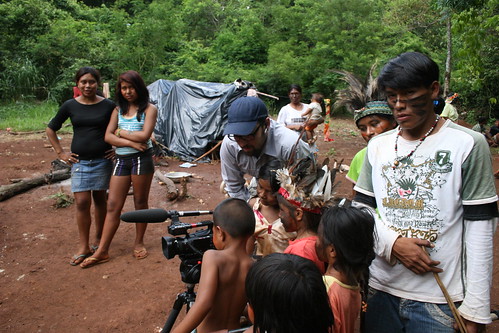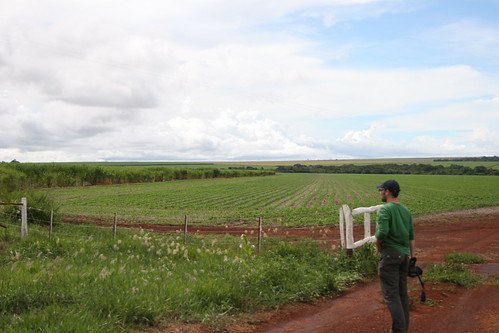It’s a problem that has resulted in violence and bloodshed: Indigenous people in Brazil who exercise their right to return to ancestral land are finding that the land has been used for farming for some time. Journalism students from the University of British Columbia traveled to Brazil to document the conflict between indigenous people and farmers that much of mainstream media has ignored until now. Angelina Irinici talks to Sam Eifling, who was part of the team whose final work was featured in The New York Times, about the project, the importance of preparation and the results their reporting produced.
It’s a problem that has resulted in violence and bloodshed: Indigenous people in Brazil who exercise their right to return to ancestral land are finding that the land has been used for farming for some time. Journalism students from the University of British Columbia traveled to Brazil to document the conflict between indigenous people and farmers that much of mainstream media has ignored until now. Angelina Irinici talks to Sam Eifling, who was part of the team whose final work was featured in The New York Times, about the importance of preparation and the results their reporting produced.

Sam Eifling in the field with the Guarani people at the makeshift village where Nisio Gomes was killed in the province of Mato Grosso do Sul. Photo: Calyn Shaw
J-Source: Once the idea was pitched and approved to investigate land claims in Brazil, what kind of preparation did the class do in order to get started?
Sam Eifling: You have to be really prepared. It’s a lot of preparation in reporting the story and making contacts and arranging travel and hotels — all that stuff has to be done before you go. We needed characters – that’s the big thing. We needed some sophisticated understanding of what we were covering and why. Five students went to the Amazon and three (which I was a part of) went south to a totally different region in the state of Mato Grosso do Sul.
For us it was finding sources and knowing that we had places to go when we hit the ground. We were working with NGOs largely to contact indigenous groups that we wound up visiting. We didn’t interview anyone from those groups for the piece but they were very helpful to us for tracking people on the ground that we could interview independently. The other side was to look at industry groups because we wanted to talk with farmers, and people who were landowners who were on the other side of the land disputes. To do that I just went through industry groups did my best to find people who spoke English and contacted them by email and by Skype and made the case that once we got there they would talk to us and get their side of the story out. Everybody we talked to on both sides of the board were very receptive.
By the time we got to Brazil we had a pretty full itinerary; we had a lot of people who were looking forward to talking to us and who saw us as a way to get their side of the story out to the wider world. It was something that had been covered in bits and pieces in the international media but not quite as comprehensively.
J-Source: The video, ‘Dying for Land,’ is posted on The New York Times’s website. How did the agreement come about with The Times to share the video?
SE: Every year the school partners with a major media organization to serve as an outlet for the piece. This year it was The New York Times largely because professor Dave Rummel was for a long time an editor in the video department at the Times. He was a good person to guide the development. Because of those ties he knew very intimately what the Times would expect. He didn’t have say or anything over what we did — we went through other editors at the Times — but he very much knew what they would expect and what editorial standards they would want to see.
Through the Times we were able to suggest to Simon Romero — their reporter in South America — to follow our reporting and do complimentary stories. So when our stories ran they were both accompanied by an independent print story by a Times correspondent which definitely raised the visibility I think. It really gave a stronger impact. Even though our concern was that it looked like we trailed Simon’s reporting, I think it worked as a partnership. The Times had suggestions once we had turned our drafts in, but they weren’t mass changes.
J-Source: After watching the video, it seems that the crew spent a lot of time with the indigenous people of Brazil. What was that experience like – how was it communicating with them and seeing the way that they live?
SE: In the south we didn’t spend as much time with them as a couple students in the north. They had to take a boat down a river to get there. At one village they had quite the trip — I think that was the part of the trip where one person got an ear infection and a few students purchased or rented hammocks in the city and ended up getting bed bugs from these hammocks.
In the south we were mostly driving in and stopping and visiting. We dropped in on a total of three villages and were very aware of the fact that our coming was an event to them, which didn’t make us entirely comfortable. In the first village we went to, many of the people — including the children — were dressed in what we’d identify as Western clothes. They had painted faces, had put on head dresses, which is, from my understanding, a way of greeting us and its also a way for them to look a certain way in the media. I think they understand there’s an interest for them in looking like who they are. When we came in there were songs and kids were dancing.
[node:ad]
At first we walked around with one of the leaders of the village … it was pretty rough. It’s not a living condition we could identify with. It was obviously very simple and very poor. They were in good moods — the people we met were very cheerful and very welcoming.
It would have been great to be able to spend more time there and talk to people more. But given the field, time constraints and shoot and the fact we only had a couple of translators, it was difficult. We really did try our best to be as respectful and friendly as we could given the constraints and work we had.
J-Source: Media reports stated that there were 18 arrests just days after the video went live. How did you find out and what was your reaction?
SE: I don’t remember how we found out. Our translator in Brazil sent us a news story so essentially it was through local media covering it there.
We were very cautious about making the claim that our reporting led to those arrests. We don’t have any evidence that there’s a real strong correlation. We feel like the history of people being arrested for similar crimes in Brazil is pretty dim and it’s probably a fair assumption that attention from a news agency like The New York Times had some affect but we can’t make that claim. When we talked to a federal prosecutor he said he could neither determine nor deny that our reporting had any affect on their investigation.
But all that said, it was pretty positive if for no other reason than it means that it’s still a living story and something we can still keep up with it. It might be a nice small step, certainly from our perspective, but it’s not as though we cracked the case and turned information over to police. But what we did is indicate that it’s a big enough issue that Brazil should take it seriously and made that had an effect on how the resources and everything were allocated on that.
The other thing that we worry about it is what if there was such an urgency that some of those aren’t good arrests? That’s a lot of arrests and I can’t imagine that there would be 18 convictions. Justice is being done, to be more optimistic, and it was certainly exciting to see, if nothing else, that the case hadn’t been ignored.
J-Source: If there is one thing that you took from that experience, whether it’s a memory you won’t forget or something that you learned, what would it be?
SE: I think it terms of reporting just knowing how chaotic everything got in the field with as many people as we had working. In my own mind now, I can’t overemphasize the importance of doing a ton of work before going on a trip like this. Once we actually got there and we were running around and things moved so quickly. Even remembering simple stuff like knowing people’s names, phone numbers and addresses is so important. [You need] to be able to access that especially without great internet access. I feel like my brain is on Gmail and I know I can just do a search for them, but guess what? Driving around in a rental car, you don’t have a data plan.
I think it’s just the real importance of finding out as much as you can and being very familiar with material before you go. Using that to not only organize your project before you go but to ask questions and get the stuff you need in the field. You’ve got one bite at it when you’re actually there and the cameras are rolling.

Sam Eifling during a roadside stop to get footage of farms in Mato Grosso do Sul. Photo: Calyn Shaw
This interview has been edited for brevity and clarity.
Angelina King is a freelance journalist who works as a reporter for CTV News Channel in Toronto. She previously reported for CTV in her hometown of Saskatoon and is a graduate of Ryerson University's journalism program. Angelina has a special interest in court and justice reporting, but is always grateful to share a human interest story. You can reach her at: @angelinakCTV.

